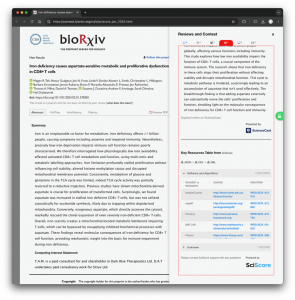
SciScore and bioRxiv Launch New Key Resource Tables for Preprints, Pioneering New Era of Reproducibility & Transparency
Surfacing reagents and resources
Through CZI’s support, SciScore has leveraged automated methods to address long-standing reproducibility issues stemming from underspecified research resources. Studies frequently lack detailed descriptions of essential materials, such as antibodies and cell lines, impeding reproducibility and potentially costing the research community millions (Freedman et al., 2015). The new Key Resource tables offer an accessible format where authors can list and link key materials directly to unique identifiers, ensuring their work is easier to replicate and understand.
SciScore’s technology scans preprints for research resources, protocols, databases, and software tools, identifying and matching them to unique RRIDs. When authors include RRIDs in their manuscripts, these identifiers automatically populate the Resource table. For resources without RRIDs, SciScore suggests the closest match, providing an easy pathway for authors to add precise identifiers. Additionally, the tables link to associated protocols and databases, creating a rich network of linked data that makes scientific research more accessible and reusable.
An initial review of the January 2024 preprints on bioRxiv revealed that 80% of the 4,133 preprints included uniquely identifiable Key Resources with an RRID. Among the 12,160 Key Resources identified across 3,378 preprints, 63% were Tools, 13% Antibodies, 7% Plasmids, 7% Cell Lines, and 5% Organisms. A more in-depth analysis is planned for a later phase.
“We are thrilled to see this project come to fruition,” said Dario Taraborelli, Science Program Officer at CZI. “Structured resource tables enhance the way researchers document and share their work and they will provide a valuable tool for authors and readers alike, significantly improving the transparency and reproducibility of preprints.”
Richard Sever, Co-Founder of bioRxiv, added, “Extracting details of reagents and linking them in this way increases transparency and represents a significant advance towards making research more reproducible. Building the SciScore tool into the bioRxiv dashboard to help achieve this is a real step forward.”
The Resource tables are enriched with schema.org elements for enhanced search indexing, making them discoverable by both researchers and search engines. Each table includes links to RRIDs.org, driving engagement with the resources and offering a model that can assist other journals in adopting similar frameworks for resource identification.
All code developed in this project is openly available under an MIT licence. RRID data extracted from preprints will be shared under a CC0 licence, promoting continued transparency and innovation in research.
Example page: https://www.biorxiv.org/content/10.1101/2024.02.01.578381v1
Anita Bandrowski
SciCrunch Inc
+31 6 47947744
email us here
Visit us on social media:
LinkedIn
Other
Distribution channels: Book Publishing Industry, Healthcare & Pharmaceuticals Industry, Media, Advertising & PR, Science, Technology
Legal Disclaimer:
EIN Presswire provides this news content "as is" without warranty of any kind. We do not accept any responsibility or liability for the accuracy, content, images, videos, licenses, completeness, legality, or reliability of the information contained in this article. If you have any complaints or copyright issues related to this article, kindly contact the author above.
Submit your press release


